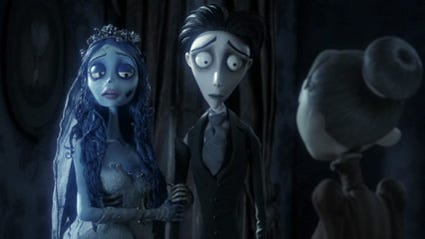The Burton Binge: "Corpse Bride"
Each Sunday with “The Burton Binge,” Sam Watermeier will look back at one of Tim Burton’s films, ultimately tracing the return to the auteur’s roots with the October 5 release of “Frankenweenie,” an animated adaptation of Burton’s first live-action short film.

“Tim Burton’s Corpse Bride” arrived like a drink to wash out the bad taste left by Willy Wonka’s chocolate factory.
With this film, Burton “returned to the painstakingly detailed medium of stop-motion animation, a resolutely hand-crafted art that, for him, contains real emotion” (“Burton on Burton”) — something “Charlie and the Chocolate Factory” lacks.
Though it may seem but a trifle in Burton’s filmography, I consider “Corpse Bride” one of his best films. Part of its charm lies in its modesty. It’s a small story, like a chapter out of Grimm’s fairy tales.
In his first straight-man role for Burton, Johnny Depp plays the nebbish Victor Van Dort. The son of nouveau riche fish merchants, Victor finds himself arranged to marry Victoria Everglot (Emily Watson), the daughter of hateful aristocrats. While Victor surprisingly sparks chemistry with Victoria, he soon finds himself in the nightmare he initially suspected — married to a woman to which he cannot possibly relate. A corpse!
Victor stumbles into this dilemma in a delightfully whimsical, Grimm-like way, strolling through the woods after ruining his wedding rehearsal. The upturned tree root on which he places his ring turns out to be the finger of a deceased bride (delicately played by Helena Bonham Carter).
It’s here where Burton performs a master-stroke of wit, painting the land of the dead as a vibrant spectacle and the world of the living as its dreary opposite — a delightfully Burtonian touch and one of the film’s many flavorful flourishes.
Somehow, the film manages to be visually spectacular without calling attention to itself — perhaps simply a result of its setting's natural, symbiotic relationship to its engrossing subject matter.
Although it is lighter in tone than its title suggests, the film is visually akin to Universal Studios monster movies of the 1930s and ’40s with its eerie rustic setting. It also shares those films’ romantic quality, which is especially evident in the movie’s musical numbers. “I know that I am dead yet it seems that I still have some tears to shed,” the corpse bride croons.
“Corpse Bride” is a tale of unrequited love as only Burton could tell it. Just as Edward Scissorhands’ deformity is a metaphor for intimacy deficiency, the bride’s rotting corpse reflects an inability to achieve human connection. It’s this ever-imaginative funhouse reflection of real world issues that makes Burton a filmmaker worth revisiting.
As Edwin Page wrote in his book, “Gothic Fantasy: The Films of Tim Burton,” “The alienation of Burton’s lead characters is an accentuated take on the otherness many of us have felt in our lives. Each of us has felt different or out of place, and can therefore empathize with these characters, though their extreme nature puts them beyond the bounds of our experiences.” As he does time and again, Burton breaks those boundaries with “Corpse Bride,” making reality and its funhouse equivalent one and the same. In turn, this creates a moment-to-moment feeling of discovery, resulting in one of Burton’s most visually and viscerally exciting films.
Perhaps the film's story isn't quite as striking or memorable as Burton's more popular animated project, "The Nightmare Before Christmas," but it remains enchanting.
Burton soon brought the same dark magic to the streets of London. Next week, I’ll discuss “Sweeney Todd: The Demon Barber of Fleet Street.”


